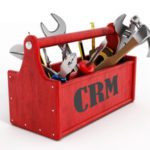Pipeline to Success
What gets measured gets done, and this can certainly be said about “non-billable” activities in law firms. For anyone familiar with attorneys, this is not surprising. Busy lawyers are tasked with competing demands for their very valuable – and very limited – time. And for lawyers, time is money – literally. So when there is client work to be done, anything that takes away from billing often ends up being put off until they have time – which sometimes means indefinitely.
But as competition for work has increased recently, law firms are finally being forced to focus on the one non-billable activity that makes all the other billable activities possible: business development. As a result, attorneys have learned that successful business development takes time. So, not surprisingly, they are now searching for technology to make this process less time-consuming and more effective. One type of technology that can help enhance law firm business development efforts has actually been ubiquitous in other industries for years: the business development pipeline (of course, most other industries call it a sales pipeline, but let’s not split hairs).
The Business Development Pipeline 
This is where real pipeline software can help to take a law firm’s business development to the next level. A true sales pipeline allows opportunities to be entered and linked to related people and companies. Pipelines also allow for entry of additional information such as activities related to an opportunity, which can then be assigned to the individuals who need to complete them. Once all the data is entered, a pipeline can also provide a perpetual history of the activities that took place during the business development cycle and reminders for activities to keep advancing the opportunities forward.
Sophisticated pipelines can also help to predict deal outcomes and forecast expected revenue. They can even be used to create dashboards and generate reports. By utilizing these types of analytics, lawyers can identify which opportunities may have become stalled or inactive and which ones may be “low hanging fruit,” the opportunities that are most likely to yield the best results with the least effort.
Most importantly, pipelines provide a good way to hold attorneys accountable for developing business. Many firms have found that pipeline activity and progress reports can be effective tools to improve results and foster a bit of healthy competition in practice group meetings.
The Past
When some larger firms with sophisticated marketing departments began to realize the limitations of spreadsheets years ago, they started looking for alternatives. But because the profession had not been focused on sophisticated business development tracking in the past, there were not many choices of business development pipeline software available that could meet the specific needs of law firms.
So as an interim solution, some firms started testing CRM software such as Salesforce to help overcome the limitations of spreadsheets. While these CRM systems included advanced pipeline functionality, unfortunately they didn’t make sense for a firm wide deployment. Even though they had been commonly used for contact management in most other industries, because they were web-based, could be extremely expensive and were hosted in the cloud rather than inside a firm’s firewall, the lawyers wouldn’t embrace them.
To compensate for a lack of attorney utilization, a few firms did have some successes with deploying a limited number of licenses to Business Development or Marketing managers who would work with key lawyers or practices and were tasked with entering the data and generating the reports. But because the systems were not readily accessible to all the lawyers, many of the key business development contacts remained where they had always been – in the attorneys’ Outlook, which made these early law firm pipelines into just more “silos” of disconnected data.
The Products
All this is changing however. Recently, some CRM developers have begun building pipeline tools to meet the changing needs of law firms. A few years ago, Microsoft began offering a version of its Dynamics CRM through industry vertical resellers who configured the software specifically for law firms. This product, CRM4Legal, has since been acquired by Aderant. Two other companies have also released new offerings built on the Dynamics platform: Business Development Premier from Thomson Reuters and ProfessionalCRM from Consulting4CRM.
More recently, LexisNexis InterAction, the industry leading CRM for large law firms, began beta testing their new Business Development Module that should be released this year and has easy data entry, automated alerts and advanced analytics and dashboards. Additionally, ContactEase from Cole Valley, the most popular CRM used by mid-sized firms, has also implemented a new Tracking Module for Opportunity and Pipeline Management. The advantage of these pipelines is that they are tied to existing CRM systems that work completely within Outlook and are typically deployed firm wide, allowing attorneys’ contacts to flow in with very little effort, time or training required. This allows a firm to better leverage relationships into opportunities and, ultimately, new matters.
Even Salesforce has finally officially entered the law firm pipeline picture through several partners including one vertical reseller whose product, OnePlace, is configured specifically for professional services. Their cloud-based system is being looked at by a few US law firms and has been adopted by one firm in Canada.
While it’s great that firms are finally focusing on business development tracking, and new pipeline software is being developed for law firms, it’s also important to make sure that we don’t forget the fundamentals of successful business development as we move forward so that we don’t repeat past failures.
The Problem 
Over the years, we have all heard way too many stories of CRM systems failing to meet expectations. What we don’t typically hear is that the reason why these systems didn’t meet expectations was often that the expectations were unrealistic. Indeed, people have been complaining about CRM systems for as long as…well, as long as there have been CRM systems (and these complaints are not limited to law firms.)
The main problem with CRM technology is that it’s just technology. It’s not a magic bullet. Lawyers shouldn’t expect that purchasing a “shiny” new piece of software is going to solve all of a law firm’s business development challenges. The software has to be implemented strategically, which means that firms have to focus not only on the technology itself, but also on the people that can make it or break it.
The People 
To ensure success, first the pipeline technology must be supported at the highest leadership levels in the law firm. Next, there must be knowledgeable, well-trained people dedicated to inputting the data. Information has to be entered correctly, consistently and completely because bad data will not inspire attorney trust. Additionally, resources have to be dedicated to ongoing data quality to ensure the data remains current over time, since up to 30% of a firm’s contact data can become outdated each year. Finally, there has to be a focus on system adoption. Lawyers not only have to understand the value of the software for the firm, but they must also believe that there is something in it for them. Only then will firms be able to get the wide-spread utilization and value that will allow them to realize return on their pipeline investment.
One final note: While there is little doubt that pipeline software can be beneficial, it also important to remember that if the lawyers don’t continuously work on “filling up” the pipeline by regularly getting out of the office to go see clients and prospects, the software isn’t really going to help. But that’s an article for another day.





Write a comment: